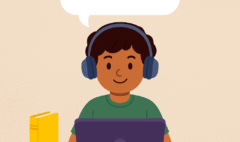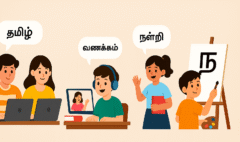Tamil for Kids: How to Talk About Emotions
Tamil for Kids: How to Talk About Emotions
Tamil for Kids: How to Talk About Emotions – A Guide to the Language of Feelings
One of the most important and profound developmental milestones for a child is learning to understand and to express their own feelings. The ability to put a name to an emotion—to say “I am happy,” “I am sad,” or “I am angry”—is the very foundation of emotional intelligence. For a child who is learning the Tamil language, being able to do this in their mother tongue is a crucial part of their development. It allows them to share their inner world with their family, to feel understood, and to build a deeper connection with their culture. Teaching the Tamil words for feelings is one of the most valuable gifts a parent can give to their child.
This guide is designed for parents and educators who want to help their children build a rich and nuanced vocabulary for their emotions. We will explore the key words for the core emotions for kids in Tamil, and we will provide simple, practical tips for how to have these important conversations. This is more than just a kids vocabulary lesson; it is a toolkit for nurturing a child’s emotional well-being and strengthening their connection to the Tamil language.
Why is This Vocabulary So Important?
Teaching a child the words for their feelings has a number of powerful benefits:
- It Validates Their Experience: When you give a child a word for what they are feeling, you are telling them that their feeling is real, that it is valid, and that you see and understand them.
- It’s the First Step to Emotional Regulation: A child who can say “I am angry” is in a much better position to learn how to manage that anger than a child who can only express it by screaming or hitting. Naming the emotion is the first step to taming it.
- It Builds Empathy: A child who can understand and name their own feelings is better equipped to understand and empathize with the feelings of others.
- It Strengthens the Parent-Child Bond: Being able to have open and honest conversations about feelings builds a deep sense of trust and connection between a parent and a child.
Part 1: The Core Emotions – The Four Basic Feelings
For young children, it is best to start with the four most basic and universal emotions. The simplest way to talk about these is to use the structure “எனக்கு … ஆக இருக்கிறது” (Eṉakku … āka irukkiṟatu), which means “I am feeling…” A simpler version for a child is to just use the feeling word itself.
1. Happiness – சந்தோஷம் (Cantōṣam)
- The Word: சந்தோஷம் (Cantōṣam) means happiness or joy.
- How to talk about it:
- When you see your child smiling and laughing, you can say, “நீ சந்தோஷமாக இருக்கிறாய்!” (Nī cantōṣamāka irukkiṟāy!) – “You are happy!”
- You can ask, “நீ சந்தோஷமாக இருக்கிறாயா?” (Nī cantōṣamāka irukkiṟāyā?) – “Are you happy?”
- Teach them to say, “நான் சந்தோஷமாக இருக்கிறேன்.” (Nāṉ cantōṣamāka irukkiṟēṉ.) – “I am happy.”
- Another beautiful word for joy: மகிழ்ச்சி (Makiḻcci)
2. Sadness – சோகம் (Sōkam)
- The Word: சோகம் (Sōkam) means sadness.
- How to talk about it:
- When your child is crying or looks upset, you can gently ask, “நீ சோகமாக இருக்கிறாயா?” (Nī cōkamāka irukkiṟāyā?) – “Are you sad?”
- It’s important to validate their feeling: “நீ சோகமாக இருப்பது சரிதான்.” (Nī cōkamāka iruppatu caritāṉ.) – “It’s okay that you are sad.”
- Teach them to say, “நான் சோகமாக இருக்கிறேன்.” (Nāṉ cōkamāka irukkiṟēṉ.) – “I am sad.”
- Another word for worry: கவலை (Kavalai). “கவலைப்படாதே” (Kavalaippaṭātē) means “Don’t worry.”
3. Anger – கோபம் (Kōpam)
- The Word: கோபம் (Kōpam) means anger.
- How to talk about it:
- Acknowledge the feeling: “நீ கோபமாக இருக்கிறாய் என்று எனக்குத் தெரிகிறது.” (Nī kōpamāka irukkiṟāy eṉṟu eṉakkut terikiṟatu.) – “I can see that you are angry.”
- Ask about the cause: “ஏன் கோபமாக இருக்கிறாய்?” (Ēṉ kōpamāka irukkiṟāy?) – “Why are you angry?”
- Teach them to say, “எனக்கு கோபம் வருகிறது.” (Eṉakku kōpam varukiṟatu.) – “I am getting angry.”
4. Fear – பயம் (Payam)
- The Word: பயம் (Payam) means fear.
- How to talk about it:
- When a child is frightened, a comforting presence is key. “பயப்படாதே, நான் இங்கே இருக்கிறேன்.” (Payappaṭātē, nāṉ iṅkē irukkiṟēṉ.) – “Don’t be afraid, I am here.”
- Ask about their fear: “உனக்கு என்ன பயம்?” (Uṉakku eṉṉa payam?) – “What are you afraid of?”
- Teach them to say, “எனக்கு பயமாக இருக்கிறது.” (Eṉakku payamāka irukkiṟatu.) – “I am feeling scared.”
Part 2: Expanding the Emotional Vocabulary for Older Kids
As a child gets older, you can introduce them to the more nuanced and complex Tamil words for feelings.
- Surprise – ஆச்சரியம் (Āccariyam)
- Love / Affection – அன்பு (Aṉpu)
- Pride – பெருமை (Perumai)
Sentence: “நான் உன்னைப் பற்றி பெருமைப்படுகிறேன்.” (Nāṉ uṉṉaip paṟṟi perumaippaṭukiṟēṉ.) – “I am proud of you.” - Shy / Embarrassed – வெட்கம் (Veṭkam)
- Excitement – உற்சாகம் (Uṟcākam)
- Tired – சோர்வு (Cōrvu)
Sentence: “நான் சோர்வாக இருக்கிறேன்.” (Nāṉ cōrvāka irukkiṟēṉ.) – “I am tired.” - Jealousy – பொறாமை (Poṟāmai)
Activities to Teach and Practice Emotional Vocabulary
- Make “Feeling Faces” in the Mirror: Stand in front of a mirror with your child. Call out an emotion in Tamil—”சந்தோஷம்!”—and make a happy face. Have your child imitate you. Then try “சோகம்” and make a sad face. This physical and visual connection is very powerful for young learners.
- Read Books and Talk About the Characters’ Feelings: When you are reading a story together, pause and ask questions about the characters. “இந்தக் கரடி சோகமாக இருக்கிறது என்று நினைக்கிறாயா?” (Intak karaṭi cōkamāka irukkiṟatu eṉṟu niṉaikkiṟāyā?) – “Do you think this bear is sad?” This helps to build empathy.
- Create “Feeling Flashcards”: Draw simple faces showing different emotions on cards and write the Tamil word on the back. You can use these to play guessing games.
- Use it in Your Daily Praise: Instead of just saying “Good job,” try to be more specific about the feeling. “நீ உன் பொம்மைகளைப் பகிர்ந்து கொண்டாய். அது மிகவும் அன்பான செயல். எனக்கு மிகவும் பெருமையாக இருக்கிறது.” (Nī uṉ pom’maikaḷaip pakirntu koṇṭāy. Atu mikavum aṉpāṉa ceyal. Eṉakku mikavum perumaiyāka irukkiṟatu.) – “You shared your toys. That was a very kind act. I am very proud.”
Conclusion: The Language of a Healthy Heart and Mind
Teaching your child the vocabulary for emotions for kids in Tamil is one of the most important things you can do for their overall development. It is a gift that helps them to build a strong foundation of emotional intelligence in Tamil and in life. By giving them the Tamil words for feelings, you are giving them the power to understand themselves, to empathize with others, and to express their own rich inner world with clarity and with confidence. This is a kids vocabulary lesson that will nurture not just their minds, but also their hearts.










